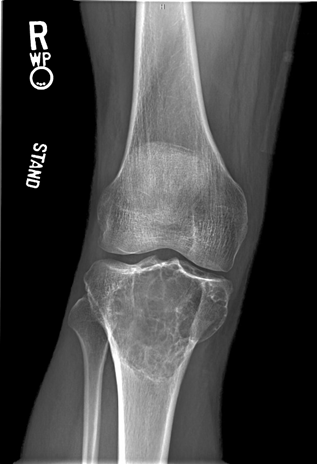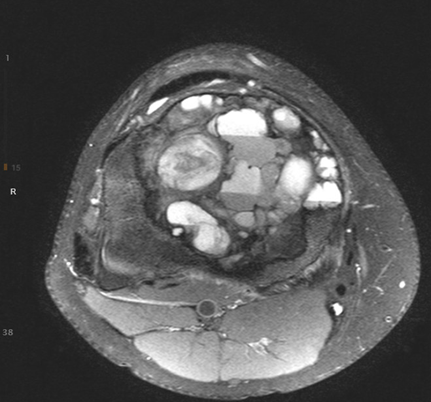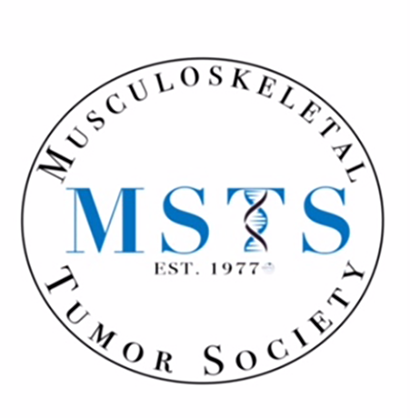Author: Kyle Sweeney, MD, FAAOS, FAOA
Description
An aneurysmal bone cyst, or ABC, is a rare, non-cancerous growth in the bone. It can happen in any bone, but it most commonly shows up near the ends of long bones like the thigh bone (femur), shinbone (tibia), or upper arm bone (humerus). It typically affects children and adolescents under the age of 20.
Sometimes, ABCs happen on their own, but they can also form with other benign (non-cancerous) bone tumors, such as giant cell tumors or chondroblastomas. Unlike simple bone cysts or unicameral bone cysts that sometimes heal on their own, ABCs do not go away without treatment. If left untreated, they tend to grow and can cause increasing pain, broken bones, deformity, and difficulty moving the affected area.
Very rarely, ABCs can also develop in soft tissue (not in bone), but this is extremely uncommon. Because ABCs are rare and sometimes complex, they are most appropriately managed by a bone tumor specialist (called a musculoskeletal oncologist or orthopedic oncologist) who has specific training and experience in diagnosing and treating these conditions.
Symptoms
- Pain: Especially during activity or when putting weight on the affected area.
- Swelling: A noticeable lump that may be tender to touch.
- Limited Movement: Difficulty moving the nearby joint.
- Neurological Symptoms: If located in the spine, it may cause back pain, numbness, tingling, or muscle weakness due to nerve compression.
Examination
In most cases there is an enlarging, painful, immobile mass as the tumor expands outside of the bone. There can also be swelling, redness, and excessive heat coming from the affected area. The mass is typically tender to touch. If it involves a weight bearing bone, walking will be painful. The pain around joints can lead to loss of joint range of motion.
Tests
X-rays of the affected area are the first step in diagnosis, often showing an expanded area of the bone with thinning of the outside cortex (the edge of the bone). The central area of the tumor will be mostly absent of bone (radiolucent) with visible septations. ABCs for multi-chambered cysts separated by these septations. (Figure 1). An MRI with contrast administered through an IV (Figure 2) should be done to help establish the diagnosis. ABCs will show the outside of the bone, or cortex is expanded and thinned. There will be multiple compartments within the mass, each with its own “fluid-fluid” level in which you see a straight horizontal demarcation between brighter fluid signal and darker sediment signal on axial T2 images.
Images
Figure 1: ABC of the proximal right tibia. Note the thinned, expanded cortex as well as the multiple chambers on the inside of the mass.

Figure 2: ABC of the right proximal tibia from the same patient as Figure 1. Note the “fluid-fluid” levels present in the various chambers within the tumor.

Prognosis
This is an extremely rare tumor. Due to its rarity, it is highly recommended that patients are treated by an orthopaedic oncologist who has experience treating these tumors. Although this tumor is classified as benign and not a cancer, it is aggressive and will continue to grow and destroy bone if left untreated. Early diagnosis and treatment are crucial to prevent complications like fractures or deformities.
The most common treatment is surgical and involves scraping the tumor out of the bone. Defects in the bone can be filled with bone graft, bone cement, or other materials, and sometimes plates and screws are needed to prevent a fracture after treatment. In some cases, doctors are using a newer method that involves injecting a medicine called doxycycline directly into the tumor. Whether this is a good option depends on the tumor’s location, size, and other factors. Your orthopedic oncologist can talk to you about whether this is right for you. Even after treatment, there is a chance the tumor can come back, which happens in about 20% to 50% of cases. That’s why regular follow-up visits are so important.
More Information
https://orthoinfo.aaos.org/en/diseases--conditions/aneurysmal-bone-cyst/
https://www.ncbi.nlm.nih.gov/books/NBK546654/
This is not intended as a substitute for professional medical advice and does not provide advice on treatments or conditions for individual patients. All health and treatment decisions must be made in consultation with your physician(s), utilizing your specific medical information. Inclusion in this is not a recommendation of any product, treatment, physician or hospital.


